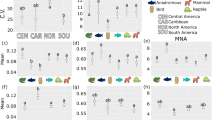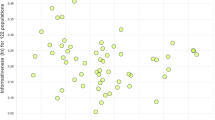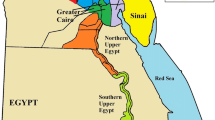Abstract
We have analysed genetic variation at 23 microsatellite loci in a global sample of 16 ethnically and geographically diverse human populations. On the basis of their ancestral heritage and geographic locations, the studied populations can be divided into five major groups, viz. African, Caucasian, Asian Mongoloid, American Indian and Pacific Islander. With respect to the distribution of alleles at the 23 loci, large variability exists among the examined populations. However, with the exception of the American Indians and the Pacific Islanders, populations within a continental group show a greater degree of similarity. Phylogenetic analyses based on allele frequencies at the examined loci show that the first split of the present-day human populations had occurred between the Africans and all of the non-African populations, lending support to an African origin of modern human populations. Gene diversity analyses show that the coefficient of gene diversity estimated from the 23 loci is, in general, larger for populations that have remained isolated and probably of smaller effective sizes, such as the American Indians and the Pacific Islanders. These analyses also demonstrate that the component of total gene diversity, which is attributed to variation between groups of populations, is significantly larger than that among populations within each group. The empirical data presented in this work and their analyses reaffirm that evolutionary histories and the extent of genetic variation among human populations can be studied using microsatellite loci.
Similar content being viewed by others
References
Barbujani G., Magagni A., Minch E. and Cavalli-Sforza L. L. 1997 An apportionment of human DNA diversity.Proc. Natl. Acad. Sci. USA 94, 4516–4519.
Barrantes R., Smouse P. E., Mohrenweiser H. W., Gershowitz H., Azofeifa J., Arias T. D. and Neel J. V. 1990 Microevolution in lower central America: genetic characterization of the Chibchaspeaking groups of Costa Rica and Panama, and a consensus taxonomy based on genetic and linguistic affinity.Am. J. Hum. Genet. 46, 63–84.
Bowcock A. M., Ruiz-Linares A., Tomfohrde J., Minch E., Kidd J. R. and Cavalli-Sforza L. L. 1994 High resolution of human evolutionary trees with polymorphic microsatellites.Nature 368, 455–457.
Calafell E, Shuster A., Speed W. C., Kidd J. R. and Kidd K. K. 1998 Short tandem repeat polymorphism evolution in humans.Eur. J. Hum. Genet. 6, 38–49.
Cann R. L., Sotneking M. and Wilson A. C. 1987 Mitochondrial DNA and human evolution.Nature 325, 548–553.
Chakraborty R. 1980 Gene-diversity analysis in nested subdivided populations.Genetics 96, 721–723.
Chakraborty R. and Jin L. 1993 Determination of relatedness between individuals by DNA fingerprinting.Hum. Biol. 65, 875–895.
Chakraborty R., Kimmel M., Stivers D. N., Davison L. J. and Deka R. 1997 Relative mutation rates at di-, tri-, and tetranucleotide microsatellite loci.Proc. Natl. Acad. Sci. USA 94, 1041–1046.
Deka R., Shriver M. D., Yu L. M., Jin L., Aston C. E., Chakraborty R. and Ferrell R. E. 1994 Conservation of human chromosome 13 polymorphic microsatellite (CA)n repeats in chimpanzees.Genomics 22, 226–230.
Deka R., Jin L., Shriver M. D., Yu L. M., DeCroo S., Hundrieser J., Bunker C. H., Ferrell R. E. and Chakraborty R. 1995a Population genetics of dinucleotide (dC-dA)n.(dG-dT)n polymorphisms in world populations.Am. J. Hum. Genet. 56, 461–474.
Deka R., Shriver M. D., Yu L. M., Ferrell R. E. and Chakraborty R. 1995b Intra- and inter-population diversity at short tandem repeat loci in diverse populations of the world.Electrophoresis 16, 1659–1664.
Deka R., Shriver M. D., Jin L., Yu L. M., Ferrell R. E. and Chakraborty R. 1998 Tracing the origin of modern humans using nuclear microsatellite polymorphisms. InThe origins and past of modern humans—towards reconciliation (ed. K. Omoto and P. V. Tobias), pp. 3–15. World Scientific, Singapore.
Di Rienzo A., Peterson A. C., Garza J. C., Valdes A. M., Slatkin M. and Freimer N. B. 1994 Mutational processes of simplesequence repeat loci in human populations.Proc. Natl. Acad. Sci. USA 91, 3166–3170.
Jin L. and Chakraborty R. 1995 Population structure, stepwise mutations, heterozygote deficiency and their implications in DNA forensics.Heredity 74, 274–285.
Jorde L. B., Bamshad M. J., Watkins W. S., Zenger R., Fraley A. E., Krakowiak P. A., Carpenter K. D., Soodyal H., Jenkins T. and Rogers A. R. 1995 Origins and affinities of modern humans: a comparison of mitochondrial and nuclear genetic data.Am. J. Hum. Genet. 57, 523–538.
Kimmel M. and Chakraborty R. 1996 Measures of variation at DNA repeat loci under a general stepwise mutation model.Theor. Pop. Biol. 50, 345–367.
Kimmel M., Chakraborty R., Stivers D. N. and Deka R. 1996 Dynamics of repeat polymorphisms under a forward-backward mutation model: within- and between-population variability at microsatellite loci.Genetics 143, 549–555.
Kimmel M., Chakraborty R., King J. P., Bamshad M., Watkins W. S. and Jorde L. B. 1998 Signature of population expansion in microsatellite repeat data.Genetics 148, 1921–1930.
Li C. C. 1976First course in population genetics. Boxwood, Pacific Grove, USA.
Livshits G. and Nei M. 1990 Relationship between intrapopulational and interpopulational genetic diversity in man.Ann. Hum. Biol. 17, 501–513.
Nei M. 1973 Analysis of gene diversity in subdivided populations.Proc. Natl. Acad. Sci. USA 70, 3321–3323.
Nei M. 1995 Genetic support for the out-of-Africa theory of human evolution.Proc. Natl. Acad. Sci. USA 92, 6720–6722.
Nei M. and Chakravarti A. 1977 Drift variances ofFst andGst statistics obtained from a finite number of isolated populations.Theor. Pop. Biol. 11, 307–325.
Nei M. and Roychoudhury A. K. 1993 Evolutionary relationships of human populations on a global scale.Mol. Biol. Evol. 10, 927–943.
Nei M. and Takezaki N. 1996 The root of the phylogenetic tree of human populations.Mol. Biol. Evol. 13, 170–177.
Nei M., Tajima F. and Tateno Y. 1983 Accuracy of estimated phylogenetic trees from molecular data.J. Mol. Evol. 19, 153–170.
Perez-Lezaun A., Calafell E., Mateu E., Comas D., Ruiz-Pacheco R. and Bertranpetit J. 1997 Microsatellite variation and the differentiation of modern humans.Hum. Genet. 99, 1–7.
Polymeropoulos M. H., Rath D. S., Xiao H. and Merril C. R. 1991 Dinucleotide repeat polymorphism at the human fms-related tyrosine kinase gene (FLT1).Nucl. Acids Res. 19, 2803.
Rao B. K., Sil S. B. and Majumder P. P. 1997 How useful are microsatellite loci in recovering short-term evolutionary history?J. Genet. 76, 181–188.
Saitou N. and Nei M. 1987 The neighbor-joining method: a new method for reconstructing phylogenetic trees.Mol. Biol. Evol. 4, 406–425.
Shriver M. D., Jin L., Chakraborty R. and Boerwinkle E. 1993 VNTR allele frequency distributions under the stepwise mutation model: A computer simulation approach.Genetics 134, 983–993.
Shriver M. D., Jin L., Boerwinkle E., Deka R., Ferrell R. E. and Chakraborty R. 1995 A novel measure of genetic distance for highly polymorphic tandem repeat loci.Mol. Biol. Evol. 12, 914–920.
Shriver M. D., Jin L., Ferrell R. E. and Deka R. 1997 Microsatellite data support an early population expansion in Africa.Genome Res. 7, 586–591.
Sokal R. R. and Rohlf F. J. 1981Biometry, 2nd edition, p. 448. Freeman, New York.
Takezaki N. and Nei M. 1996 Genetic distances and reconstruction of phylogenetic trees from microsatellite DNA.Genetics 144, 389–399.
Tishkoff S. A., Dietzsch E., Speed W., Pakstis A. J., Kidd J. R., Cheung K., Bonné-Tamir B., Santachiara-Benerecetti A. S., Moral P., Krings M., Pääbo S., Watson E., Risch N., Jenkins T. and Kidd K. K. 1996 Global patterns of linkage disequilibrium at the CD4 locus and modern human origins.Science 271, 1380–1387.
Weber J. L. and Wong C. 1993 Mutation of human short tandem repeats.Hum. Mol. Genet. 2, 1123–1128.
Author information
Authors and Affiliations
Corresponding author
Rights and permissions
About this article
Cite this article
Deka, R., Shriver, M.D., Mei Yu, L. et al. Genetic variation at twentythree microsatellite loci in sixteen human populations. J Genet 78, 99–121 (1999). https://doi.org/10.1007/BF02924561
Received:
Revised:
Issue Date:
DOI: https://doi.org/10.1007/BF02924561




